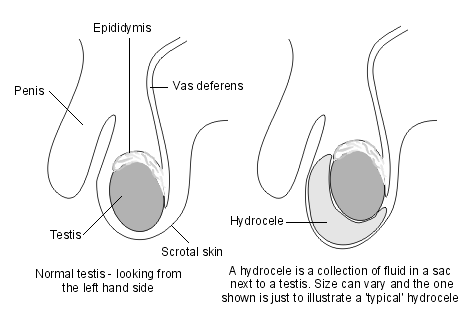Hydrocele in infants
Peer reviewed by Dr Philippa Vincent, MRCGPLast updated by Dr Toni Hazell, MRCGPLast updated 14 Nov 2024
Meets Patient’s editorial guidelines
- DownloadDownload
- Share
- Language
- Discussion
In this series:Scrotal lumps, pain and swellingTesticular torsionEpididymo-orchitisEpididymal cystVaricoceleHydrocele in adults
A hydrocele is a collection of fluid in the scrotum, sometimes found in newborn boys. Most hydroceles go down within the first few months of life in babies and so do not need treatment. If a hydrocele persists then a small operation can usually cure the problem.
In this article:
Continue reading below
The normal scrotum and testes
The scrotum is normally loose, soft and fleshy. It holds the two testicles (testes). Usually you can easily feel the testes in the scrotum. A tube (the vas deferens) takes sperm from each testicle (testis) to the penis. It is normal for one testis to hang lower than the other.
What is a hydrocele?
A hydrocele is a collection of fluid in a sac in the scrotum next to a testicle (testis). It usually occurs on one side but sometimes a hydrocele forms over both testicles (testes). It is common in newborns.
Diagram of a hydrocele

The normal testis is surrounded by a smooth protective tissue sac. You cannot normally feel this. It makes a small amount of 'lubricating' fluid to allow the testis to move freely. Excess fluid normally drains away into the veins in the scrotum. If the balance is altered between the amount of fluid that is made and the amount that is drained, some fluid accumulates as a hydrocele.
Continue reading below
What do hydroceles look and feel like?
A hydrocele feels like a small fluid-filled balloon inside the scrotum. It feels smooth and is mainly in front of one of the testicles (testes). They can vary in size. Hydroceles are normally painless. Sometimes fluid can move back and forth between the hydrocele and the abdominal cavity - this is called a communicating hydrocele and you might see swelling that appears to move between the tummy (abdomen) and the scrotum. Another type of hydrocele is called non-communicating, where the fluid stays in the scrotum. There may be no hydrocele symptoms - your baby is unlikely to be in pain - but you might notice an apparent lump or swelling in the scrotum.
What causes hydroceles?
Some babies are born with a hydrocele. Hydroceles are very common in babies. When babies develop in the womb (uterus), the development of the testicles (testes) sees the testicles move from the tummy (abdomen) to the scrotum. Sometimes the passage which allows this to happen (the processus vaginalis) does not close completely. This may then lead to a hydrocele developing.
Hydroceles can sometimes be associated with an inguinal hernia, which occurs when part of the intestine pushes through a weak spot in the muscles of the abdominal wall.
In older children a hydrocele may have other causes such as injury, torsion of the testis or nephrotic syndrome.
Continue reading below
Are any investigations needed for hydrocele?
The diagnosis of hydrocele can normally be made by history and examination. If there is doubt about the nature of the scrotal lump, an ultrasound may be needed.
What is the treatment for hydrocele?
Hydroceles usually improve without any treatment within the first year of life. An operation is usually only advised if the hydrocele persists after 12-24 months of age.
If your child also has a hernia, often seen as a lump in the groin area, then this will usually be corrected in the same operation.
The operation for a hydrocele involves making a very small incision (cut) in the lower tummy (abdomen) or the scrotum. Sometimes the procedure is done by keyhole surgery (laparoscopically). The fluid is then drained from around the testicle (testis). The passage between the abdomen and the scrotum will also be sealed off so the fluid cannot reform in the future. This is a minor operation and is performed as a day case, so does not usually involve an overnight stay in the hospital.
There are no long-term effects of having a hydrocele. Having a hydrocele does not affect the testicles (testes) or a boy's ability to have children in the future.
Patient picks for Other conditions

Children's health
Eczema in children
Most children with eczema have atopic eczema, but some children with eczema have a different condition called contact dermatitis - which is a reaction to a substance on or near the skin. It is not unusual for a child with atopic eczema to also have contact dermatitis to certain products applied to the skin. There are other types of eczema, which are much less common in children.
by Dr Colin Tidy, MRCGP

Children's health
Childhood obesity
If your child is overweight or obese, they have an increased risk of developing various health problems and are more likely to become an overweight adult.
by Dr Laurence Knott
Further reading and references
- Verma S, Agrawal V, Acharya H, et al; Laparoscopic suture-less herniotomy using tissue-sealing device for paediatric hydrocele. J Minim Access Surg. 2019 Jan 4. pii: 249452. doi: 10.4103/jmas.JMAS_251_18.
- EAU Paediatric Urology Guidelines. Edn. presented at the EAU Annual Congress Copenhagen; European Association of Urology, 2018 - updated 2023
Continue reading below
Article history
The information on this page is written and peer reviewed by qualified clinicians.
Next review due: 13 Nov 2027
14 Nov 2024 | Latest version

Ask, share, connect.
Browse discussions, ask questions, and share experiences across hundreds of health topics.

Feeling unwell?
Assess your symptoms online for free
Sign up to the Patient newsletter
Your weekly dose of clear, trustworthy health advice - written to help you feel informed, confident and in control.
By subscribing you accept our Privacy Policy. You can unsubscribe at any time. We never sell your data.